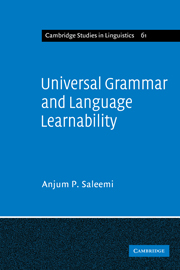Book contents
- Frontmatter
- Contents
- Preface
- 1 The problem of language learnability
- 2 The components of the linguistic system
- 3 The components of the learning system
- 4 Approaches to parameter fixation
- 5 The scope and limits of the current approaches
- 6 The distribution and variety of null subjects
- 7 Augmented parameter fixation: pro subjects and learnability
- 8 Review and integration
- Notes
- References
- Index
8 - Review and integration
Published online by Cambridge University Press: 04 August 2010
- Frontmatter
- Contents
- Preface
- 1 The problem of language learnability
- 2 The components of the linguistic system
- 3 The components of the learning system
- 4 Approaches to parameter fixation
- 5 The scope and limits of the current approaches
- 6 The distribution and variety of null subjects
- 7 Augmented parameter fixation: pro subjects and learnability
- 8 Review and integration
- Notes
- References
- Index
Summary
It seems that the parameter-setting model has considerable explanatory potential, but that a convergence of a linguistic perspective on learnability, such as the one inherent in parametric theory, and the more formal approaches to language learning, would considerably benefit both these fields. Thus the present study, which represents a contribution to the linguistic investigation of learnability, relies significantly on certain parallels with formal models. With respect to parameter fixation, two apparently contradictory conclusions are in order.
Firstly, it would appear that parameter fixation is not as simple a process as has been claimed. It is clear that the ‘no learning theory’ hypothesis (e.g. Chomsky 1981,1986a, Hyams 1986) is far from obviously correct, and that the postulation of at least a domain-specific learning theory is essential (Manzini and Wexler 1987, Wexler and Manzini 1987). The parametersetting model may embody a relatively simple view of language learning, but this view entails potentially very complex consequences, which are very poorly understood at present.
Secondly, complex though it might be in the sense stated above, the model may turn out to be rather trivial in relation to the complexity of the task required of it. A major achievement of the parametric model is that it is capable of explaining the basic variability of the class of possible grammatical systems directly in terms of the process of acquisition. So it affords a perspective on cross-linguistic diversity that is unifiable with a method of acquiring each member of the class of grammars by using the same set of learning mechanisms.
- Type
- Chapter
- Information
- Universal Grammar and Language Learnability , pp. 136 - 139Publisher: Cambridge University PressPrint publication year: 1992



